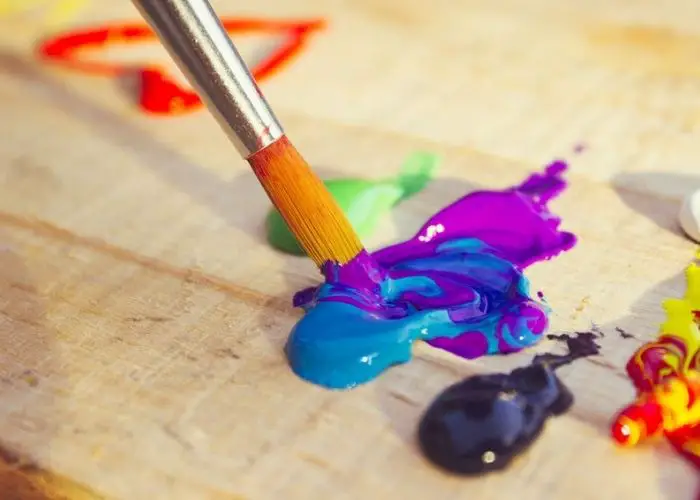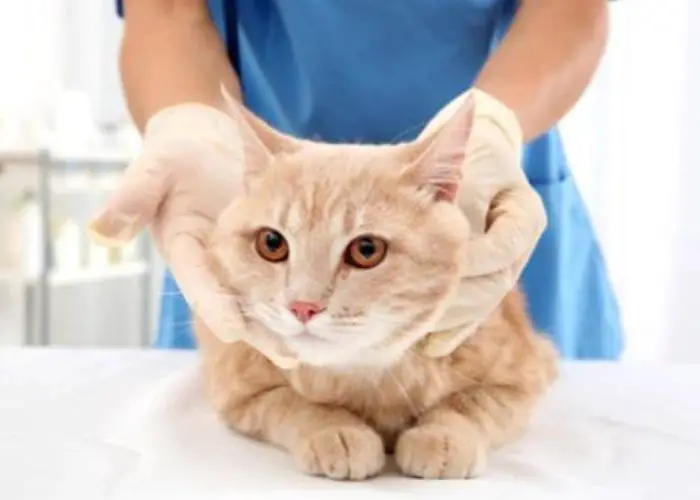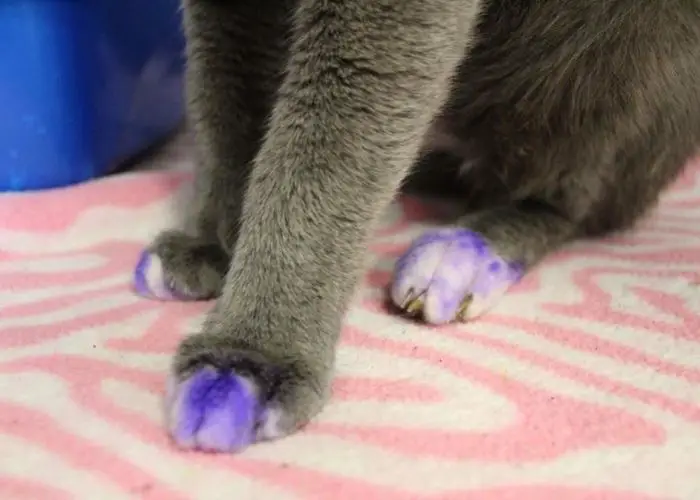Many pet owners are curious if acrylic paint is toxic to cats. The truth is, while acrylic paint is generally non-toxic to cats, it can still cause some health problems if ingested in large quantities.
In this article, we will discuss the main uses of acrylic paints, as well as the dangers of ingestion and how to treat your cat in the event of a paint poisoning.
So, are acrylic paints toxic to cats? Let’s find out!
Is Acrylic Paint Toxic to Cats?
No, acrylic paint is not toxic to cats when used as intended. However, if a cat ingests a large amount of paint, it can cause gastrointestinal upset and possibly even liver damage.
Acrylic Paint and Its Main Uses

Acrylic paint is a water-based polymer. Acrylics were first used in the 1930s and have been increasingly popular since the 1950s.
Acrylics are versatile, reliable, and easy to use. They can be thinned with water, but once dry, they are waterproof.
Acrylics come in a wide range of colors, including traditional tube colors, mixing colors, metallic colors, pearlescent colors, and fluorescent colors.
Acrylics can be used for a variety of purposes, including painting on canvas, painting on wood, painting on glass, painting on ceramic, and more.
Is Acrylic Paint Toxic to Cats?
Acrylic paint is considered non-toxic (they do not contain volatile organic compounds) when used as intended. Most acrylic paints brands are water-based, making them safe for cats to be around.
However, if your cat eats acrylic paint in large quantities, it can cause health problems. Symptoms of ingestion include vomiting, diarrhea, drooling and abdominal pain.
If your cat ingests a large amount of paint, contact your veterinarian immediately.
Is Acrylic Paint Safe For Cat Paws?
Acrylic paint is safe for cats to walk on when it is dry. However, wet acrylic paint can be toxic to cats if ingested.
If your cat walks through wet acrylic paint, clean its paws with soap and water to remove any residue.
Signs and Symptoms of Paint Toxicity in Cats
It’s no secret that cats have a bit of a reputation for being curious creatures.
They like to explore their surroundings, and sometimes that can lead them into mischief – like climbing up the walls or getting into paint cans.
So while a few licks of paint might not seem like a big deal, it can actually be quite dangerous for your feline friend.
Paint toxicity in cats can cause a range of serious symptoms, from gastrointestinal upset to liver damage.
So if you think your cat has been licking paint, it’s important to be on the lookout for the following signs and symptoms.
- Vomiting and diarrhea are common signs of paint toxicity in cats.
- If your cat is suddenly experiencing these symptoms, it could be because they’ve ingested paint.
- Other gastrointestinal signs to watch out for include loss of appetite, abdominal pain, and excessive drooling.
- You may also notice that your cat seems unusually lethargic or uncoordinated.
- In serious cases, paint toxicity can lead to liver failure and death.
If you suspect that your cat has been exposed to paint, it’s important to seek veterinary treatment immediately. With prompt medical care, most cats will make a full recovery.
What Should You Do If Your Cat Ingests Acrylic Paint?

Should your cat ingest acrylic paint, the first thing you should do is consult your veterinarian or the ASPCA’s Animal Poison Control Center at (888) 426-4435.
If your cat has a history of gastrointestinal issues, it’s particularly important to seek professional medical help immediately.
While not all cases of ingestion are serious, some can lead to blockages or other health complications. In addition, ingesting large amounts of paint can also be toxic.
If you’re unable to get to a vet right away, there are a few things you can do to help your cat.
- First, try to keep them calm and quiet. Too much activity can cause the paint to spread through their system more quickly and potentially cause more damage.
- If possible, give them small amounts of water or cat milk to drink. This will help to flush the paint out of their system and prevent dehydration.
- Finally, keep an eye on their stool. Once the paint starts to come out, they’ll likely be back to normal in no time.
When Is Acrylic Paints Not Safe For Cats?
While acrylic paint is generally safe for cats, there are some situations when it is not.
Airbrushing
Airbrushing is a technique that uses compressed air to spray paint onto a surface. It is often used for painting vehicles or large pieces of equipment.
If your curious cat is in the same room as you while you are airbrushing, there is a risk that they will inhale the paint fumes.
Inhaling paint fumes can cause irritation on the skin and mucus membranes.
Sanding
Sanding is another activity that can release paint fumes into the air. If you are sanding acrylic paint surface, be sure to do it in a well-ventilated area.
If your cat is in the same room as you, there is a risk that they will inhale the paint fumes.
How to Get Paint Out of Cat Fur
If your cat has gotten paint on their fur, don’t panic. You can take a few simple steps to remove the paint and get your cat back to its normal self.
- First, remove as much dried paint as possible with a blunt knife or a spoon.
- Once you’ve removed as much paint as you can, soak a cloth in warm water and gently rub it over the affected area. This will help to loosen the remaining paint.
- If the paint is still not coming off, you can try using a mild dish soap or shampoo.
- Work the soap into the fur and then rinse it off with warm water.
- You may need to repeat this process a few times before the paint is completely removed.
What Paint is Safe for Cats?
If you are looking for a paint that is safe for cats, there are a few things you should look for.
First, make sure that the paint is labeled as non-toxic. Secondly, check the ingredients list to ensure that it does not contain harmful chemicals.
Finally, look for a paint that is specifically designed for use around pets. These paints are typically made with natural ingredients that are safe for animals.
Read Also: What Paint is Safe for Fish?
What To Look For In Acrylic Paints That Are Safe For Cats
When choosing an acrylic paint that is safe for cats, there are a few things you should look for.
- Make sure that the paint is labeled as non-toxic.
- Check the ingredients list to ensure that it does not contain harmful chemicals.
- Look for a paint that is specifically designed for use around pets. These paints are typically made with natural ingredients that are safe for animals.
- You should also watch out for certain colors of paint. Some colors, such as red and yellow, contain more toxins than others.
If you are unsure about a particular color of paint, it is best to err on the side of caution and choose another color.
Is Wall Paint Toxic To Cats?
Most wall paints are safe for cats, but there are some that contain toxins that can be harmful to your pet.
If you are unsure about the safety of a particular paint, it is best to contact the manufacturer for more information.
You should also be aware that some paints may be safe for cats but not for other animals. For example, oil-based paints can be toxic to birds.
Is Oil Paint Toxic To Cats?
Generally speaking, oil paint is not toxic to cats. However, there are a few things to keep in mind.
First of all, some oil paints may contain lead or other heavy metals, which can be dangerous if ingested.
Also, oil paint fumes can be harmful if inhaled, so it’s important to make sure your cat has plenty of ventilation if you’re using oil paints in your home.
But, overall, there’s no need to worry about your cat getting into your oil paints.
Is Water-Based Paint Toxic To Cats?

Water-based paints such as latex paints and artist paints are generally safe for cats, but there are some that contain toxins that can be harmful to your pet.
Always check the label to ensure the paint is non-toxic and safe for animals.
If you’re unsure, it’s always best to err on the side of caution and keep your cat away from any paint fumes or wet paint.
Is Acrylic Paint Toxic To Birds?
While the paint itself isn’t toxic, the fumes can be harmful if inhaled in large quantities.
So, if you’re looking to add a splash of color to your avian friend’s cage, make sure to do so in a well-ventilated area.
Also, keep in mind that some birds are more sensitive to fumes than others, so it’s always best to err on the side of caution.
In short, while acrylic paint isn’t necessarily harmful to birds, it’s not exactly good for them either. So, use it sparingly and make sure they have plenty of fresh air.
Is Acrylic Paint Toxic To Dogs?
As with cats, acrylic paint is not toxic to dogs. However, some water-based paints contain toxins that can be harmful if ingested.
Also, like cats, dogs can be sensitive to fumes, so it’s important to make sure your pet has plenty of ventilation if you’re using acrylic paints in your home.
Overall, though, there’s no need to worry about your dog getting into your acrylic paints.
FAQs
Is acrylic paint pet safe?
Yes, as long as it is non-toxic and doesn’t contain any harmful ingredients, it is safe for pets. However, always check the label to be sure.
What paints are toxic to cats?
While most paints are safe for cats, some can be toxic. The main culprit is lead, which is found in some older paints. If a cat ingests lead paint, it can lead to serious health problems, including neurological damage and kidney disease. Other potentially toxic ingredients include zinc oxide and chromium oxide. So if you’re planning on doing some painting, keep your cat well out of the way!
What is the safest paint for cats?
The safest paint for cats is a non-toxic paint that doesn’t contain any harmful ingredients. However, always check the label to be sure.
How do you get acrylic paint off a cat?
If your cat has gotten into some wet paint, the best thing to do is to wipe it off with a damp cloth gently. If the paint is already dry, you can try using a pet-safe shampoo or conditioner to help loosen it. Once you’ve loosened the paint, you can gently brush it out with a soft-bristled brush. Of course, if all else fails, you can always take your cat to the vet for a professional cleaning.
How do you keep cats away from paint?
The best way to keep cats away from paint is to keep them out of the room where you’re painting. If that’s not possible, try covering any exposed paint water with tape or plastic sheeting. You can also try using a pet-safe deterrent spray to help keep them away. Finally, clean up any paint spills immediately, as cats are attracted to the smell of wet paint.
How much paint is toxic to cats?
No set amount of paint is considered toxic to cats. However, if a cat ingests paint that contains lead, it can lead to serious health problems, including neurological damage and kidney disease. So it’s best to keep your cat away from any wet paint or fumes.
Can you paint with cats in the house?
Yes, you can paint with cats in the house if you take precautions. First, make sure to use non-toxic paint that is safe for animals. Second, keep your cat out of the room where you’re painting and ensure plenty of ventilation. Finally, clean up any paint spills immediately.
Is acrylic paint safe for kids?
There’s no need to worry about your kids getting their hands on some acrylic paint – acrylic paint is perfectly safe for them to use. In fact, it’s actually a great medium for kids to try out, as it is very forgiving and easy to work with. Acrylic paint is also non-toxic, so you don’t have to worry about your kids inhaling any harmful fumes.
Conclusion
Acrylic paint is safe for cats as long as it is non-toxic and doesn’t contain any harmful ingredients.
However, always check the label to be sure. If your cat does ingest paint, contact your veterinarian immediately.
And, as with all animals, keep them out of the room while you’re painting and ensure plenty of ventilation.
Thanks for reading! We hope this helped answer your question.











Leave a Reply